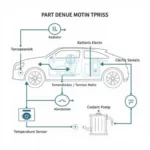A vehicle OBD2 scanner is an essential tool for any car owner or mechanic. It allows you to tap into your vehicle’s onboard computer, retrieve diagnostic information, and understand the story behind those blinking dashboard lights.
What is a Vehicle OBD2 Scanner?
OBD2 stands for On-Board Diagnostics, second generation. It refers to a standardized system that allows external devices, like scanners, to communicate with a vehicle’s engine control unit (ECU). Essentially, it acts as a translator, converting complex data from your car’s computer into understandable codes and information.
Why Do You Need a Vehicle OBD2 Scanner?
Imagine your car starts acting up. Instead of rushing to a mechanic for a potentially costly diagnosis, you can use an OBD2 scanner to:
- Identify the Problem: Retrieve and decipher trouble codes (DTCs) that indicate specific issues within your vehicle’s systems.
- Reset Check Engine Light: After addressing the issue, you can use the scanner to clear the check engine light, saving you a trip to the mechanic.
- Monitor Real-Time Data: View live sensor readings for various parameters like engine RPM, coolant temperature, fuel efficiency, and more.
- Enhance Performance: Some advanced scanners enable performance tuning and modifications for experienced users.
- Save Money: By diagnosing problems yourself, you can potentially avoid unnecessary repairs and expensive mechanic visits.
Types of Vehicle OBD2 Scanners: Finding the Right One for You
Choosing the right OBD2 scanner depends on your needs and budget. Here’s a quick breakdown:
- Basic Code Readers: These affordable scanners provide DTCs and their definitions, suitable for identifying simple issues.
- Bluetooth Scanners: Connect wirelessly to your smartphone or tablet, offering user-friendly apps with additional features like data logging and graphing.
- Advanced Scanners: Offer comprehensive functionalities, including live data streaming, advanced diagnostics, and even coding capabilities, ideal for professional mechanics and enthusiasts.
How to Use a Vehicle OBD2 Scanner
Using a basic OBD2 scanner is surprisingly simple:
- Locate the OBD2 Port: Usually found under the dashboard on the driver’s side.
- Plug in the Scanner: Turn the ignition on (engine off).
- Read and Interpret Codes: The scanner will display any stored or pending DTCs.
- Research and Resolve: Look up the code definitions online or in a repair manual to understand the issue and proceed with repairs.
- Clear Codes: Once resolved, use the scanner to clear the codes and reset the check engine light.
Choosing the Right Vehicle OBD2 Scanner
When selecting an OBD2 scanner, consider the following factors:
- Vehicle Compatibility: Ensure the scanner supports your car’s make, model, and year.
- Features: Determine which features are essential for your needs, such as code reading, live data, graphing, and more.
- User Interface: Look for a scanner with an intuitive and easy-to-navigate interface.
- Budget: Set a budget and explore scanners within your price range, comparing features and value.
Vehicle OBD2 Scanners: Empowering Car Owners
A vehicle OBD2 scanner is no longer a tool exclusive to mechanics. It’s an empowering device that puts car owners in control, allowing them to understand their vehicles better and make informed decisions about maintenance and repairs. By investing in an OBD2 scanner, you’re investing in knowledge, convenience, and potentially, long-term savings.
FAQs
1. Will an OBD2 scanner work on any car?
OBD2 scanners are designed to work on most cars manufactured after 1996 in the United States and after 2001 in Europe. However, it’s essential to check compatibility with your specific vehicle before purchasing.
2. Can I fix any problem with an OBD2 scanner?
While an OBD2 scanner can help diagnose problems by providing trouble codes, it doesn’t fix them. It’s crucial to research the codes and understand the underlying issues before attempting any repairs.
3. What is the difference between a code reader and a scanner?
Code readers are basic devices that primarily retrieve and display DTCs. Scanners offer more advanced features, like live data streaming, graphing, and additional diagnostic capabilities.
4. Are OBD2 scanners difficult to use?
Most OBD2 scanners are user-friendly, especially the ones designed for personal use. They often feature intuitive interfaces and straightforward instructions.
5. What should I look for in a good OBD2 scanner app?
A good OBD2 scanner app should be user-friendly, provide clear code definitions, offer data logging and graphing functionalities, and have regular updates for compatibility and feature enhancements.
6. Where can I get help interpreting OBD2 codes?
Numerous online resources, forums, and repair manuals provide detailed information and guidance on understanding and addressing specific OBD2 trouble codes.
7. Can an OBD2 scanner drain my car battery?
Leaving an OBD2 scanner plugged in for extended periods when the engine is off could potentially drain your car battery. It’s advisable to disconnect it after use.
Need Assistance?
For expert advice and support on choosing the right OBD2 scanner for your needs, contact us via WhatsApp: +1(641)206-8880 or Email: [email protected]. Our dedicated team is available 24/7 to assist you.


